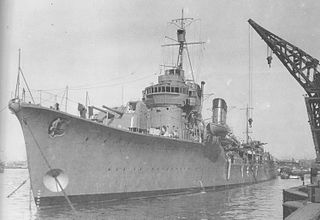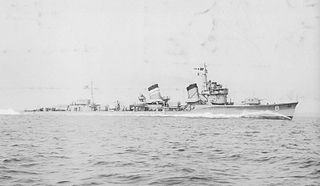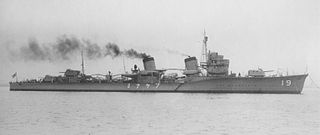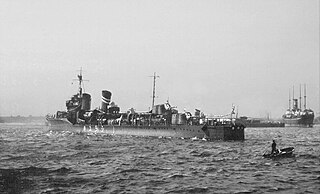 W
WThe Fubuki-class destroyers were a class of twenty-four destroyers of the Imperial Japanese Navy. The Fubuki class has been described as the world's first modern destroyer. The Fubuki class set a new standard not only for Japanese vessels, but for destroyers around the world. They remained formidable opponents to the end of World War II, despite being much older than many of their adversaries.
 W
WAkebono was the eighteenth of twenty-four Fubuki-class destroyers, built for the Imperial Japanese Navy following World War I. When introduced into service, these ships were the most powerful destroyers in the world. They served as first-line destroyers through the 1930s, and remained formidable weapons systems well into the Pacific War.
 W
WAmagiri was the 15th of 24 Fubuki-class destroyers, built for the Imperial Japanese Navy following World War I. When introduced into service, these ships were the most powerful destroyers in the world. They served as first-line destroyers through the 1930s, and remained formidable weapons systems well into the Pacific War. She is most famous for ramming the PT-109 commanded by Lieutenant John F. Kennedy, who would later become the 35th President of the United States.
 W
WAsagiri was the thirteenth of twenty-four Fubuki-class destroyers, built for the Imperial Japanese Navy following World War I. When introduced into service, these ships were the most powerful destroyers in the world. They served as first-line destroyers through the 1930s, and remained formidable weapons systems well into the Pacific War.
 W
WAyanami was the eleventh of twenty-four Fubuki-class destroyers, built for the Imperial Japanese Navy following World War I. When commissioned, these ships were the most powerful destroyers in the world. They served as first-line destroyers through the 1930s, and remained formidable weapons systems well into the Pacific War.
 W
WFubuki was the lead ship of twenty-four Fubuki-class destroyers, built for the Imperial Japanese Navy following World War I. When introduced into service, these ships were the most powerful destroyers in the world. They served as first-line destroyers through the 1930s, and remained formidable weapons systems well into the Pacific War. Fubuki was a veteran of many of the major battles of the first year of the war, and was sunk in Ironbottom Sound during the Battle of Cape Esperance in World War II.
 W
WHatsuyuki was the third of twenty-four Fubuki-class destroyers built for the Imperial Japanese Navy following World War I. When introduced into service, these ships were the most powerful destroyers in the world. They served as first-line destroyers through the 1930s, and remained formidable weapons systems well into the Pacific War.
 W
WIsonami was the ninth of twenty-four Fubuki-class destroyers, built for the Imperial Japanese Navy following World War I. When introduced into services, these ships were the most powerful destroyers in the world. They served as first-line destroyers through the 1930s, and remained formidable weapons systems well into the Pacific War.
 W
WMiyuki was the fourth of twenty-four Fubuki-class destroyers, built for the Imperial Japanese Navy (IJN) following World War I. When introduced into service, these ships were the most powerful destroyers in the world. They served as first-line destroyers through the 1930s, and remained formidable weapons systems well into the Pacific War.
 W
WMurakumo was the fifth of twenty-four Fubuki-class destroyers, built for the Imperial Japanese Navy following World War I. When introduced into service, these ships were the most powerful destroyers in the world. They served as first-line destroyers through the 1930s, and remained formidable weapons systems well into the Pacific War.
 W
WOboro was the seventeenth of twenty-four Fubuki-class destroyer, built for the Imperial Japanese Navy following World War I. When introduced into service, these ships were the most powerful destroyers in the world. They served as first-line destroyers through the 1930s, and remained formidable weapons systems well into the Pacific War.
 W
WSagiri was the sixteenth of twenty-four Fubuki-class destroyers, built for the Imperial Japanese Navy following World War I. When introduced into service, these ships were the most powerful destroyers in the world.
 W
WSazanami was the nineteenth of twenty-four Fubuki-class destroyers, built for the Imperial Japanese Navy following World War I. When introduced into service, these ships were the most powerful destroyers in the world. They served as first-line destroyers through the 1930s, and remained formidable weapons systems well into the Pacific War.
 W
WShikinami was the 12th of 24 Fubuki-class destroyers, built for the Imperial Japanese Navy following World War I. When introduced into service, these ships were the most powerful destroyers in the world. They served as first-line destroyers through the 1930s, and remained formidable weapons systems well into the Pacific War.
 W
WShinonome was the sixth of twenty-four Fubuki-class destroyers, built for the Imperial Japanese Navy following World War I. They served as first-line destroyers through the 1930s, and remained formidable weapons systems well into the Pacific War.
 W
WShirakumo was a Fubuki-class destroyer and the eighth in a class of twenty-four vessels built for the Imperial Japanese Navy following World War I. When introduced into service, these ships were the most powerful destroyers in the world. They served as first-line destroyers through the 1930s, and remained formidable weapons systems well into the Pacific War.
 W
WShirayuki was the second of twenty-four Fubuki-class destroyers, built for the Imperial Japanese Navy following World War I. When introduced into service, these ships were the most powerful destroyers in the world. They served as first-line destroyers through the 1930s, and remained formidable weapons systems well into the Pacific War. Shirayuki was sunk in the Battle of the Bismarck Sea on 3 March 1943 while under attack by American and Australian aircraft.
 W
WUranami was the tenth of twenty-four Fubuki-class destroyers, built for the Imperial Japanese Navy following World War I. When introduced into service, these ships were the most powerful destroyers in the world. They served as first-line destroyers through the 1930s, and remained formidable weapons systems well into the Pacific War.
 W
WUshio was the twentieth of twenty-four Fubuki-class destroyers, built for the Imperial Japanese Navy following World War I. When introduced into service, these ships were the most powerful destroyers in the world. They served as first-line destroyers through the 1930s, and remained formidable weapons systems well into the Pacific War. Ushio was one of only two of the 24 ships in its class to survive World War II, and it was also the only survivor out of the 22 combat ships involved in the Pearl Harbor assault force.
 W
WUsugumo was the seventh of twenty-four Fubuki-class destroyer, built for the Imperial Japanese Navy following World War I. When introduced into service, these ships were the most powerful destroyers in the world. They served as first-line destroyers through the 1930s, and remained formidable weapons systems well into the Pacific War.
 W
WYūgiri was the fourteenth of twenty-four Fubuki-class destroyers, built for the Imperial Japanese Navy following World War I. When introduced into service, these ships were the most powerful destroyers in the world. They served as first-line destroyers through the 1930s, and remained formidable weapons systems well into the Pacific War.